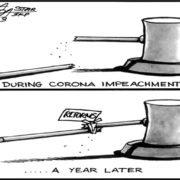THE past couple of days were most eventful for the Philippines — with the unfolding of a series of both fortunate and unfortunate events.
On May 25, at least 14 Filipino marines and Abu Sayyaff militants perished during a gunbattle in a new US-backed offensive which aimed to rescue six foreign and Filipino hostages near coastal Patikul town in Sulu province.
Six marines and about 10 gunmen were wounded in the encounter, as reported by Philstar.com.
This was probably one of the reasons why the United States issued a travel advisory, warning US citizens against traveling to Mindanao, due to threats of kidnapping of foreign nationals in the region.
Canada, the UK and Australia also followed suit, issuing their own respective travel advisories to their citizens, which warned of possible terrorist attacks and kidnappings in some parts of Mindanao.
Despite the advisories, Malacañang assured that the government will try its best to provide safety for both Filipinos and foreigners in the country.
Meanwhile, a United Nations report revealed that “disasters seriously threaten the growth prospects of vulnerable countries like the Philippines and can result in huge losses and heavier debt burdens,” according to Philstar.com.
Released this month, the Global Assessment Report on Disaster Risk Reduction 2013 (GAR) assessed that countries, which have experienced “intensive disasters may never recover lost growth in the medium or long term,” Philstar.com further reported.
“In countries with frequent severe cyclones – such as Madagascar and the Philippines – and large fiscal gaps, growth will be lower over several decades,” GAR noted.
“The opportunity for the Philippines is to make its economic growth more resilient and thus also reduce poverty as the poor are the worst hit by disasters,” Senior Regional Coordinator for Asia Pacific the UN Office for Disaster Risk Reduction Jerry Velasquez said.
According to GAR, “some middle-income countries, such as Philippines, have high levels of risk because their exposed produced capital is more vulnerable than in high-income countries due to weaker building structure and material. The impact that this has on expected annual average loss highlights the risks of making business investments in countries with higher levels of vulnerability an important consideration for investors.”
Yet, despite the GAR’s assessment, the country bagged the New Frontiers Award 2013 (an international award for disaster recovery) early this week, “for successfully bouncing back from the devastation of typhoon Pablo in December 2012,” according to Philstar.com.
“This award highlights the sheer resilience of our people and the resolve of all stakeholders to fast-track recovery. Despite these crises, we remain undaunted and focused in showing our visitors that we are worth visiting,” Department of Tourism (DOT) Secretary Ramon Jimenez Jr. said in a statement.
Adding more sheen to the country’s already-bright tourism prospects is the recognition of three beaches in the Philippines as among 100 best in the world by CNN: Palau Island in Cagayan Valley (ranking 10th); El Nido in Palawan (ranking 14th) and Puka Beach in Boracay (ranking 84th).
According to DOT, tourist arrivals continue to increase in the first four months of 2013 (up 10.6 percent from the same period in 2012).
On the business front, four Filipinos made it to Forbes Asia’s Heroes of Philanthropy regional list: Henry Sy, Sr.; John Gokongwei, Jr.; Felino Palafox, Jr.; and Joel Cruz.
Also this week, the Philippines moved up five places in the latest World Competitiveness Report of the International Institute for Management Development (IMD) — from the 43rd spot in 2012 to the 38th in 2013, in a review of 60 economies.
But what is perhaps the crowning glory of all the country’s most recent accolades is an astounding growth in the Philippine economy for the first quarter of 2013: a whopping 7.8 percent — surpassing the economic growths of China and other ASEAN countries; and going beyond the 7.1 percent growth recorded in the fourth quarter of 2012.
“The robust growth was boosted by the strong performance of manufacturing and construction, backed up by financial intermediation and trade,” National Statistical Coordination Board Secretary General Jose Ramon Albert said.
World Bank Country Director Motoo Konishi sees the robust growth as “exciting,” indicating that their is global confidence for the efforts being done by the Philippine government.
“I think it goes well with the next step, which is much more aggressive reforms that can be undertaken so that this whole growth can be shared equitably,” said Konishi to Philstar.com.
While we’ve had our share of both the good and the bad, it is a bit comforting to see that to some extent, the good outweighs the bad, and that there is a sense of renewed hope and confidence among Filipinos.
But going beyond major achievements and accolades, what’s best for our nation is to have citizens who know how to count their blessings.
(AJPress)





